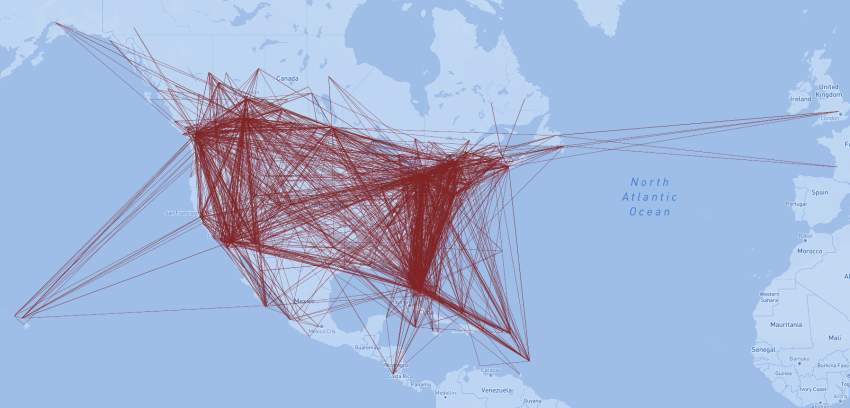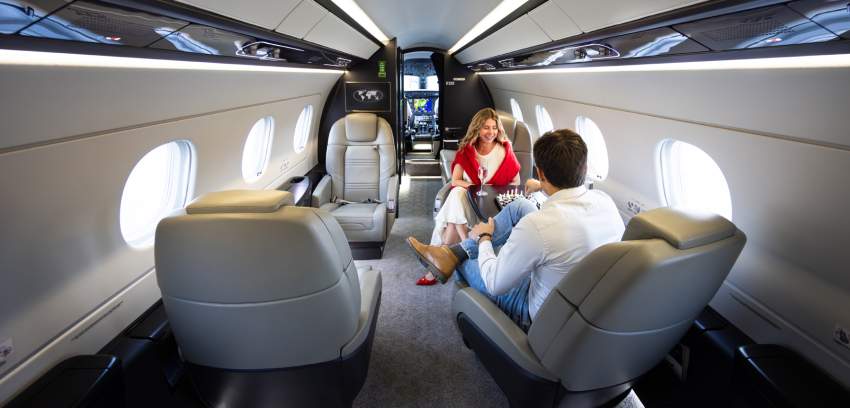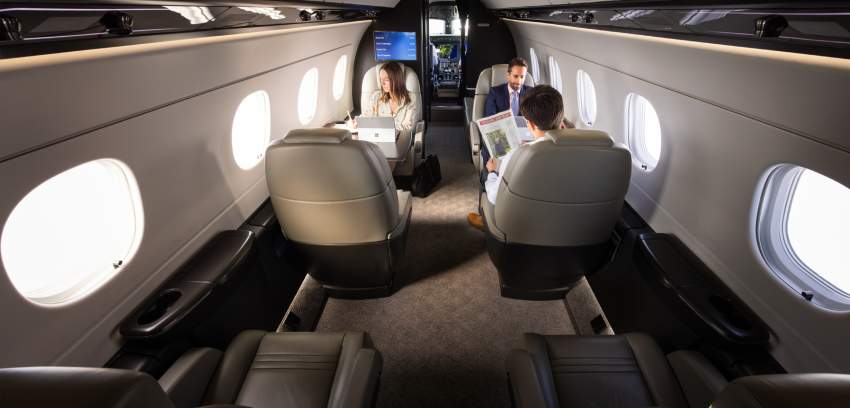With 25 years of experience, AirSprint is at the forefront of Canada’s private aviation boom—capturing more than half of the market’s recent growth.
This white paper explores how AirSprint’s 40-aircraft fleet, coast-to-coast operational coverage, and uniquely Canadian approach to Fractional Jet Ownership combine to deliver a superior private aviation experience. With guaranteed access, no positioning fees, and service from both major cities and remote communities, AirSprint offers an efficient, reliable, and personalized alternative tailored to the evolving needs of Canadian travellers.
Overview
Private Flying in Canada
The Covid-19 global pandemic was the catalyst that created a fundamental shift in Canadian demand for private aviation services.
More and more people realized the benefits of flying private and bookings soared. Compared to 2019 (the last full year before the pandemic), overall demand for private flights has increased by approximately 50 per cent in Canada, according to aviation data firm WINGX—and more than half of those new requests have been serviced by AirSprint Private Aviation.
Founded in 2000, AirSprint is the Canadian pioneer in Fractional Jet Ownership. Over the 12 months between April 2024 and March 2025, AirSprint grew an impressive 14 per cent year over year, despite the fact that the pandemic officially ended more than two years ago.
“We represent 29 per cent of the overall Canadian private jet market based on departures,” said James Elian, President and CEO of AirSprint. “Our next largest competitor is at eight per cent.”
The AirSprint fleet of aircraft has grown along with post-pandemic demand for private aviation services, with the roster totalling 40 aircraft in March 2025. Four jets were onboarded in the preceding six months alone.

AirSprint’s Fractional Jet Ownership model has proven to be the strongest and fastest-growing private aviation model in Canada.
Elian’s research shows that private aviation has grown significantly in North America overall, although Canada started from a lower adoption rate.
“Canada’s use of private aviation is smaller than in the U.S.,” he explained. “There are over 17,000 private jets in the U.S. and roughly 700 here in Canada. So, when comparing adoption in the two countries, Canada has historically been quite a bit behind the U.S.—but we’ve seen a significant shift.”
Even in the first three months of 2025, AirSprint flights were up 12 per cent over the same time period last year.
“Flying remains strong,” confirmed Elian. “Our product and service offering is still in demand. Sales increased in Q1 2025 compared to Q1 2024, and when we look at utilization hours compared to what’s available in the system, we’re at 100 per cent.”
In fact, AirSprint’s Fractional Jet Ownership model has proven to be the strongest and fastest-growing private aviation model in Canada, even landing the company in the 2024 Report on Business ranking of Canada’s Top Growing Companies.
Elian recalled that when AirSprint introduced Fractional Jet Ownership to Canada a quarter century ago, some were sceptical.
“But we figured out a way to do it,” he said. “We’ve been the national option for 25 years now, and we’ve been profitable every year of our existence. We compete with U.S. competitors on the trans-border routes every single day.”
When it comes to those routes, AirSprint goes up against the likes of NetJets and Flexjet, respectively the largest and second-largest private jet providers in the U.S. Elian noted that Canadian-based AirSprint is the tenth busiest North American private jet provider.
He said AirSprint can take Canadians wherever they want to go in the U.S. and other countries—but also anywhere within Canada. Although the company is based in Calgary, AirSprint jets are busiest in Ontario and Quebec, with complete coverage offered from B.C.’s Vancouver Island to St. John’s, Newfoundland & Labrador.
“Nobody has access to Canada the way AirSprint does,” said Elian. “Our flying is the same as it has been for many years now. There’s nothing more powerful than looking at our map. We’ve flown more than 6,500 unique airport pairs across Canada, the U.S. including Hawaii, the Caribbean, South America and Europe.”

The map above is a snapshot of AirSprint's flight operations from Janurary 2025 to May 2025.
AirSprint’s white glove service has grown in popularity; adoption has been quick as Fractional Owners realize the unparalleled convenience of flying from their local airports.
Even as more flights criss-cross Canada, Elian expects to see Fractional Owners increasingly travelling to European destinations, as the world economy continues to diversify. He said the company plans to acquire even longer-range aircraft in the future to facilitate more non-stop flying.
“Travel is necessary in uncertain economic times like these,” he commented. “A private aircraft is a crucial tool for Canadian business people who want to meet with suppliers and customers, wherever they are, to further cement those relationships.
Continued Elian: “Face to face conversation is key in business when times are uncertain. Countries can sometimes have disagreements, but business relationships built over the years are often much stronger.”
Thanks to its focus on secondary and tertiary markets as well as major centres, one of the most important benefits AirSprint delivers is uniform access to private aviation services across Canada.
Compared to the U.S., smaller Canadian airports don’t offer regular access to private aviation services. However, since AirSprint does not charge for aircraft positioning, a Fractional Owner who chooses to live in rural Canada enjoys the same top tier service as those who live in the country’s largest centres.
How It Works
The AirSprint Model
Today, AirSprint provides customized private aviation services for more than 550 Fractional Owners.
Essentially, Fractional Owners purchase or lease a share of an aircraft and pay an Annual Overhead Fee covering the fixed costs, such as pilot salaries, crew training, insurance, maintenance, hangar storage and administrative support.
In return, they are allocated a set number of flight hours per year, beginning at 25 Annual Hours and increasing in increments of 25. They are then charged a fixed hourly rate for the time spent on board.
At AirSprint, Fractional Owners are guaranteed access to their jet or an identical model with as little as 24 hours’ notice.
“As a business tool overall, AirSprint allows our Owners to take advantage of the service at a price point that is within reach of more people,” Elian pointed out. “Because of our high utilization, shared ownership structure, and stable model, people have a lot of flex. It’s not all or nothing.”
He explained that the company was intentionally structured to be operationally stable from day one. That means there are several key differences between AirSprint and the large U.S. fractional providers.

One of the most important benefits AirSprint delivers is uniform access to private aviation services across Canada.
“If you look at the different models in the U.S., they had put options written into their contracts. This means that after a certain amount of time, the aircraft share could be sold back to the company at a discount. We never had put options in our model because we didn’t have the capital for buybacks in the beginning."
“So, we reversed it—we said you can sell your fractional share at any point you like. That means Fractional Owners are in control of the process and they can decide the time of sale and price point for their share. AirSprint assists in the process—helping to locate a buyer and ensuring the share is sold at market price.”
The other factor contributing to the company’s stability is the Annual Overhead Fee paid by Fractional Owners, which covers fixed costs. This fee is paid upfront, so the company always has the resources to look after the assets of its Fractional Owners.
“Financially, I don’t think there are any other aviation operations that are as stable as we are,” said Elian. “This provides Fractional Owners with the comfort of knowing that AirSprint will continue to be financially viable while managing their valuable assets.”
In the current economic landscape, AirSprint has taken further measures to ensure its financial stability. In a market where new aircraft deliveries are significantly delayed from OEMs, gently flown pre-owned aircraft are the best option.
“It gives us the most flex in a fluid market,” confirmed Elian. “The market has been changing significantly; so from a pricing dynamic, pre-owned two or three-year-old models make more sense. It gives us more flexibility to protect customers from increased prices, and we can weather economic uncertainty because we don’t have a bunch of aircraft coming that might be tariffed.”
In the Industry
How AirSprint Stacks Up
How does AirSprint compare to its U.S.-based competitors? Elian said one key point is that AirSprint is not a new company.
Over the 25 years it has been doing business, it’s been a clear leader in the field.
“We are the busiest private jet operator in the country by triple,” he noted. “We are the fastest-growing. We can do almost everything the American fractionals can do, with true and unrestricted Canadian access and point-to-point travel.”
Plus, there’s the company’s longstanding open door policy, with every Fractional Owner having access to Elian’s cell number. Despite its size, AirSprint maintains a very personalized and highly responsive service.
Another key benefit, especially in uncertain economic times, is that many fees are charged in Canadian dollars—with the exception of the aircraft fractional share itself.

AirSprint’s Fractional Owners enjoy a range of unparalleled travel benefits in their “private office in the sky.”
Aside from those benefits, it’s interesting to note that AirSprint represents a larger share of the Canadian private jet market than NetJets’ corresponding share south of the border. In fact, the Canadian company accounts for just under 30 per cent of national private jet travel. Comparatively, NetJets has 15 per cent of the U.S. market, with all fractional ownership companies together accounting for about 23 per cent of private jet activity in that country, according to WINGX.
“So, overall, this means that the adoption of Fractional Ownership in Canada has been significant, and AirSprint has a bigger share of its respective pie,” said Elian.
Canadians have been quick to seize on the benefits of flying private, especially since the pandemic.
AirSprint’s Fractional Owners enjoy a range of unparalleled travel benefits in their “private office in the sky.” These include easier and more efficient travel; Canada-wide coverage and access to destinations in the U.S., Caribbean, South America and Europe; guaranteed flights with just 24 hours’ notice; tailored services from a Personal Flight Concierge; locked in pricing for predictable budgeting; and the ability to upsize or downsize their aircraft if required. Plus, Owners have the peace-of-mind that comes from AirSprint’s spotless safety record.
Of course, there’s also the benefit of having more time for the things that matter most!
“I don’t think I’ve ever heard a Fractional Owner say the benefits of private aviation are less than they’d expected,” concluded Elian.
With AirSprint, your jet is ready when you are.

Our fractional owners love our service
True Canadian Hospitality | Abby Gnanendran
© 2025 AirSprint Inc. All rights reserved. This paper was produced for AirSprint by Mustang Media Writing & Editorial Services
